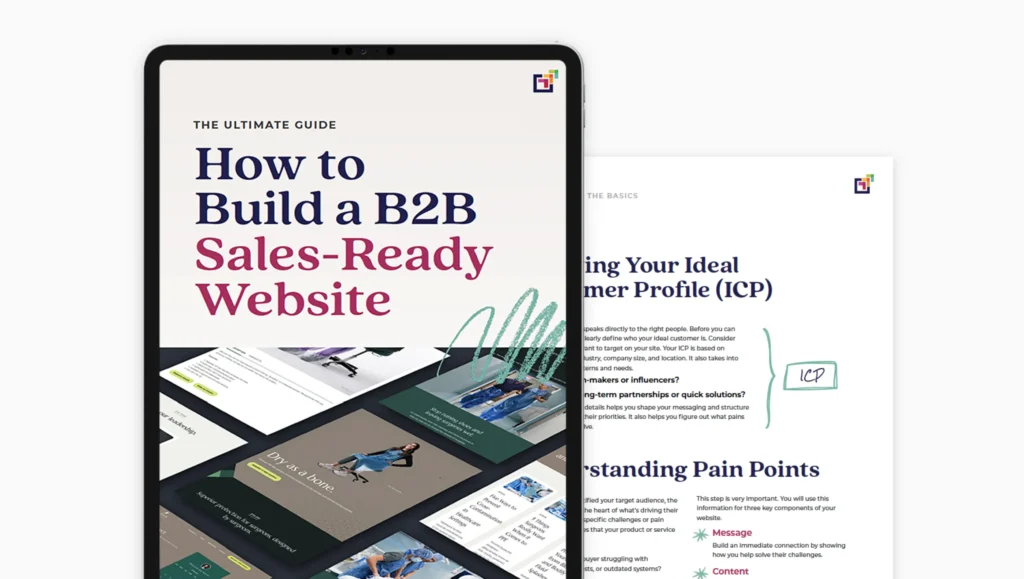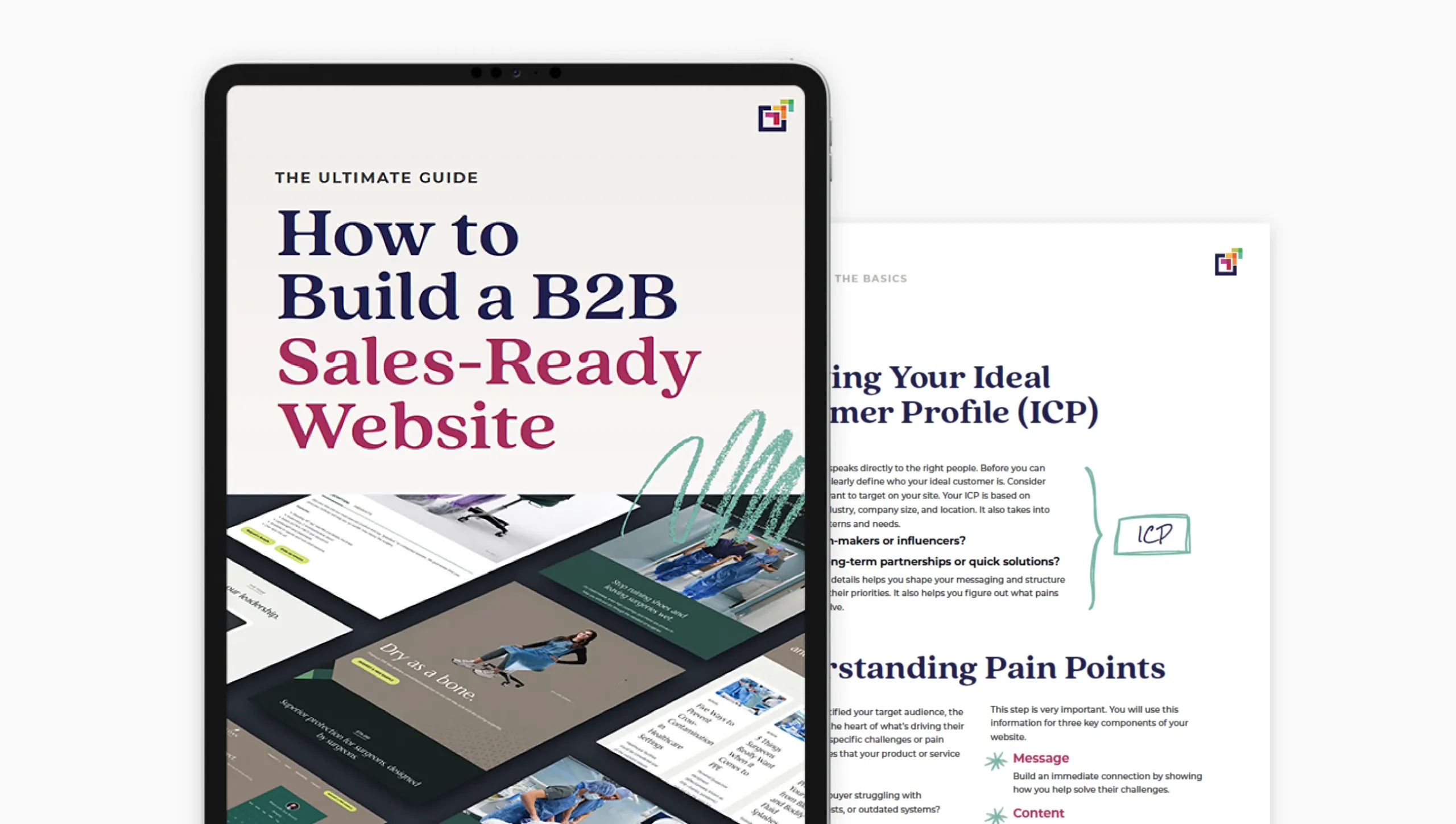It’s 2025: You already know that every business needs a website. Depending on your business model, the structure, strategy, and content of B2B and B2C websites need to be significantly different.
The strategies that drive conversions for a business selling directly to consumers (B2C) differ drastically from those targeting other businesses (B2B). If you’re a B2B business, your sales cycle is longer, and that means your website needs to do a lot more heavy lifting for your sales team. Your market and your customers are more complicated, too. Solutions are much more complex in the B2B context, and your buying committee is up to 5 times as large as a B2C decision.
So what’s a B2B business to do? Start by understanding the four biggest differences between B2B and B2C websites.
1. B2B Websites Need to Support a Long, Long Sales Cycle
In the B2B world, buying decisions don’t happen overnight like those (sometimes impulsive) purchases we see in B2C. There’s a lot less at stake when you’re just choosing a pair of pants or a car repair shop as a B2C buyer… when you’re talking about $100,000 annual contracts that impact dozens, or even hundreds, of employees in your business, the game changes.
B2B buying is more of a thoughtful, step-by-step process – and that takes time. B2B sales cycles are just plain longer, involving a lot of research, several decision-makers, and intricate internal evaluations. So, when it comes to your B2B website, think of it as an “always available” sales rep for your business, fostering connections and nurturing leads over time. It’s running a marathon instead of a sprint.
Here, content marketing becomes your best friend. Strategically chosen and expertly written content provides valuable insights through comparisons, case studies, and educational content, guiding potential partners through every phase of the sales journey. B2B websites should go the distance in offering detailed product, service, or solution information. Beyond basic descriptions and images, they should include in-depth specifications, technical documents, and even tools like ROI calculators to help your clients make well-informed choices.
It’s a lot more than you have to provide to sell a pair of pants.
For example, a company selling enterprise software to other businesses might offer in-depth white papers discussing industry-specific challenges and how their product offers solutions. This builds trust and positions them as experts, facilitating the long-term engagement crucial for B2B success. This approach caters to the 64% of new B2B buyers who prefer digital channels for research and engagement [2]. This extended engagement also impacts lead generation.
While B2C e-commerce often focuses on direct sales, B2B websites primarily aim to capture leads for sales reps to nurture, recognizing that personal interaction remains vital in many B2B sectors.
B2B Websites Need to Explain More Complex Integrations, Regulations, and Outcomes
B2B products and services are often intricately woven into a company’s existing infrastructure, operations, and regulatory landscape. B2B websites have to address these complexities head-on so that buyers feel informed and ready to talk. This includes clearly outlining integration processes, how your solution meets compliance requirements, and your potential impact on their business outcomes.
For instance, a company selling medical equipment needs to address relevant FDA regulations and provide documentation demonstrating compliance. Similarly, a SaaS provider must clearly explain how their software integrates with, or replaces, existing CRM systems or other essential tools.
A robust FAQ section becomes invaluable here, addressing common queries about integration challenges, regulatory hurdles, and expected ROI. This proactive approach builds confidence in your buyer and reduces potential friction in the sales process.
Even though B2B buyers are accustomed to, and really do need, more detailed information, your website’s design and messaging still need to be simple, clear, and easy to understand. Information architecture becomes crucial [8].
The site should be structured logically, allowing users to quickly find the specific information they need without feeling overwhelmed. This means providing clear navigation, intuitive search functionality, and well-organized content hubs. This directly impacts conversion rates, which in B2B often focus on lead conversion, demo requests, or contact form submissions rather than immediate purchases.
This depth of information is rarely necessary in the B2C space, where products are typically standalone and regulations are less complicated.
B2B Website Content Needs to Address a Much Larger Buying Committee
In B2C, purchasing decisions are often made by a single individual – maybe two. B2B, on the other hand, typically involves a buying committee containing various roles and responsibilities – and a wide variety of pain points and objections.
Your B2B website content has to speak to the entire buying audience, addressing the specific needs and concerns of each stakeholder. This means providing information relevant to technical experts, financial decision-makers, and executive leadership. For example, a website selling cybersecurity solutions might include technical specifications for IT professionals, ROI projections for CFOs, and executive summaries outlining strategic benefits for CEOs.
This also impacts how “social proof” content, like case studies, is presented. For example, while testimonials and user reviews are valuable in both B2B and B2C, B2B case studies should delve deeper into quantifiable results to address all the potential concerns of different stakeholders.
More content is always good, so consider downloadable resources like white papers, webinars targeting specific pain points, and personalized email campaigns. Speaking of personalization, don’t skip it: 66% of B2B buyers expect fully or mostly personalized content when shopping online.
By addressing the needs of the entire buying committee, the website facilitates consensus-building and accelerates the decision-making process.
B2B Websites Need to Clarify Complex Ideas Quickly
While detailed information is essential in B2B, it needs to be presented clearly and concisely. B2B buyers are often pressed for time and expect information to be easily digestible.
This requires striking a balance between comprehensiveness and clarity. Your B2B website design should prioritize intuitive navigation and a streamlined user experience, ensuring that users can quickly find the information they need without getting lost in technical jargon or convoluted explanations.
Visual aids like infographics, explainer videos, and interactive diagrams can be invaluable in conveying complex concepts quickly and engagingly.
For example, a company selling complex industrial equipment could use 3D models and animated demonstrations to showcase how the product works and its key features. Similarly, a SaaS provider could utilize interactive product tours to guide users through their platform’s functionality. This approach acknowledges that while B2B buyers value in-depth information, they also expect a user-friendly experience comparable to consumer websites [8].
Most importantly, make your website fast and easy for leads to convert on. Don’t hide your CTAs, and don’t create forms that are difficult to complete or too long.
How Much Do Agencies Charge for Website Design? B2B vs. B2C
The cost of website design can vary significantly depending on the complexity of the project, the agency’s expertise, and your business’s specific needs.
B2B websites, due to their often more complex functionality and content requirements, can be a little more expensive to develop than very simple B2C sites. B2B website features like CRM integrations, robust account management portals, and interactive product configurations are all important tools, and they take time to develop.
B2C websites, while often visually appealing, may have simpler functionality, focusing primarily on product presentation and maybe e-commerce capabilities.
However, both B2B and B2C websites benefit from investing in high-quality design that aligns with their specific target audience and business objectives. A well-designed website, regardless of the business model, is an investment that pays dividends in the long run.
Start With a B2B Website Audit to Know What’s Important
So, now you know the most important distinctions between B2B and B2C websites. You might be looking at your B2B website thinking, “Is my website costing me deals?”
Well… it could be.
Before running out and finding a B2B website design agency or diving into a website redesign or optimization project on your own, kick things off with a thorough website audit. This step helps you get a clear picture of how your current website is doing, spot areas that could use a little TLC, and craft a strategy that’s just right for your needs.
If you’re in the B2B space, your audit should focus on conversion optimization, the quality and relevance of your content, the user experience, and how well the site supports the often intricate B2B sales cycle.
Not sure how to audit your site? We can help! Just pop your information into our website audit tool, and we’ll run your website through our 78-point audit. We’ll email you the results, and you’ll get some quick-fix action items that can help you get started.





